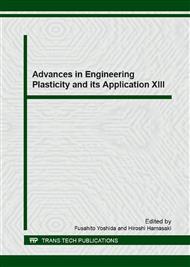p.659
p.665
p.671
p.677
p.683
p.689
p.695
p.700
p.706
On the Scale Dependence of Micro Hydromechanical Deep Drawing
Abstract:
Tooling feature size to minimum thickness becomes small in micro scale products and its ratio affects the deformation behavior in micro sheet forming significantly. In this study, the effect of this relative tooling feature size on drawing characteristics and effects to improve the drawability, such as friction holding effect, hydrodynamic lubrication effect and compression effect by blank edge radial pressure, in micro hydromechanical deep drawing (MHDD) are investigated using plasticity theory and numerical simulation. The results show that the micro drawing characteristics in MHDD can be improved by applying counter pressure. However, the required fluid pressures for friction holding and hydrodynamic lubrication effects increase as the relative punch diameter and/or die shoulder radius to thickness decrease, although the compression effect by radial pressure on the blank edge is independent of the relative tooling feature size.
Info:
Periodical:
Pages:
689-694
Citation:
Online since:
December 2016
Price:
Сopyright:
© 2017 Trans Tech Publications Ltd. All Rights Reserved
Share:
Citation:


